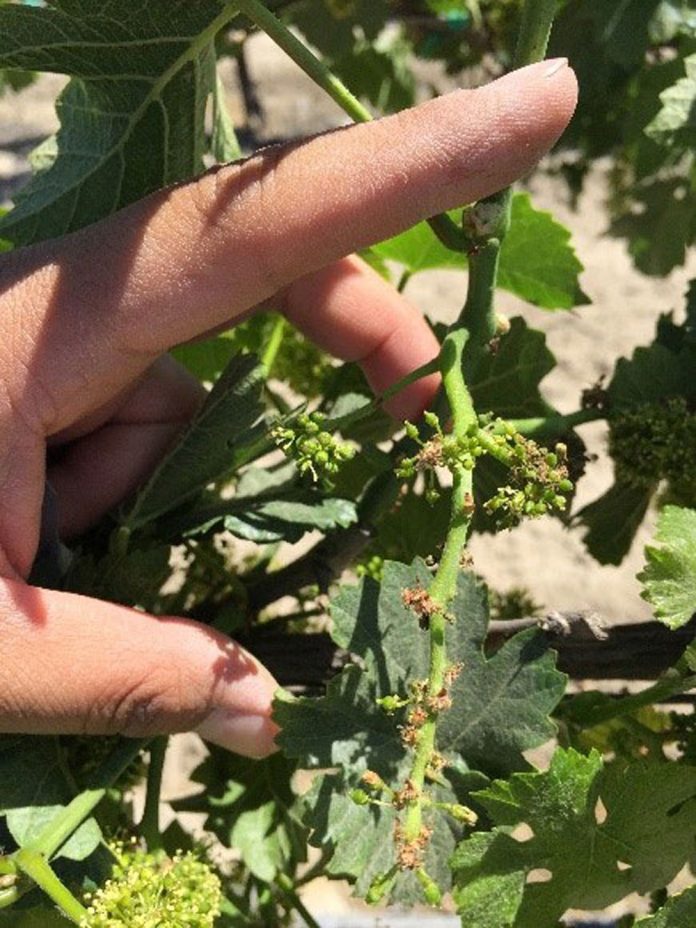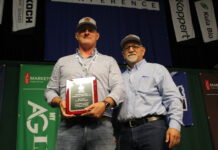After 2021 grapevine budbreak, we received many calls about dead spurs, delayed bud break, stunted shoot growth and poor fruit set. In Fresno County, some severely impacted vineyards suffered a substantial yield loss. In many cases, the problem was delayed spring growth (DSG), and the classic vine symptoms include:
- Delayed and erratic bud break
- Stunted shoot growth
- Excessive berry shatter and poor fruit set
The situation was apparently spread across different grape growing regions in California, and UC Davis Department of Viticulture and Enology held a virtual grower meeting to discuss it (the recorded presentation can be found on the UC Davis AggieVideo website.)
Delayed Spring Growth
Grapevine DSG is associated with insufficient rehydration of the vines and may be due to vascular tissue injury, insufficient carbohydrate reserves, excessively dry soil over winter or some combination of these factors. Symptoms can result in significant yield loss and permanent vine damage, resulting in economic hardship for growers. Some vine DSG symptoms are similar to other pest/disease symptoms (e.g., vine trunk disease or soil pests like nematodes/phylloxera.) However, most vineyards we visited had little or no sign of trunk disease or soil pests. Several factors this past fall and winter contributed to widely observed and severe vineyard DSG symptoms:
- Ongoing drought and increasingly dry soils, especially over winter in vineyards which were not sufficiently irrigated postharvest, or during winter
- Warmer than normal fall temperatures, including a particularly warm October
- A sudden freeze in early November
According to CIMIS station data at Five Points, October 2020 was warmer than the last five years’ average and followed a sudden freeze event in November (Figure 1), and warmer-than-normal autumn is a risk factor for DSG. In addition to the November freeze event, October and November 2020 were mostly dry, and a drier autumn could make the freeze worse. Even though the minimal temperature of the 2020 winter might be lower than the last five years’ average according to the CIMIS station data, the DSG’s occurrence and severity varied significantly across vineyards in Fresno County and other parts of California.

Also, vineyard management, particularly postharvest and winter irrigation, could make a big difference on the results of DSG even if the ambient weather condition was similar. The geographic location as well as vineyard microclimate can sometimes mean quite different consequences in the face of freeze damage. Figure 2 illustrates the variation of daily minimum temperatures from five locations in Fresno County. Typically, vineyards located on the west side had a lower minimal temperature and suffered more freeze damage than vineyards located on the east side. Sand Ranch in particular had the lowest daily minimum temperature among five locations from October to March.

To make matters worse, Fresno County saw much less precipitation during the months of November and December 2020 than the last 20 years’ average (Figure 3). These drier months might offer the perfect conditions for DSG. Although precipitation amount was normal in January 2021, February was yet another dry month in comparison to historical averages. Lack of soil moisture before bud break is another major risk factor for DSG.

Grapevine winter freeze damage and DSG have similar symptoms and can be difficult to differentiate. Winter cold damage or freeze injury damages vascular tissues and can thus interfere with water, carbohydrate and mineral translocation, causing symptoms similar to DSG. A lack of soil moisture can impair vine rehydration, making vines suffer water stress and causing DSG symptoms directly. Additionally, vines might be more vulnerable to cold injury even though the minimal temperature in the past winter, such as 25 degrees F at Sand Ranch, might not cause significant freeze damage on most Vinifera grapes.
Maintain Vine Health
Vineyard conditions should be considered to avoid DSG and possible cold damage:
- Abiotic or biotic stressed vines (e.g., severe water stress and overcrop, nutrient deficiency, pest/disease)
- Young vines
- Late ripening and cold tender varieties
- Certain rootstocks, including Freedom and Harmony
- Insufficient soil moisture during the dormant period (e.g., October to March in the San Joaquin Valley)
Generally, maintain vine health over the growing season and assess soil moisture as the vines enter dormancy, watering if needed. Too many clusters with not enough leaf area can weaken the vines and deplete the trunk and root’s carbon reserves, which are needed to maintain respiration over winter, help prevent freezing and nourish the vines as they regrow in the spring. To maintain a functional vine canopy, irrigate as necessary to support photosynthesis without stimulating excessive growth. If pests or diseases are present in the vineyard, such as powdery mildew, nematodes, grapevine trunk disease, virus, mites and leaf hopper, a good assessment of canopy health is important. Grapevines with severe defoliation or small canopies will be of great concern, and management should focus on better addressing pest and disease problems to avoid early defoliation.
A young vine has its inherent nature of vulnerability due to a lack of sufficient carbon reserves. Therefore, severe water stress and overcropping should be avoided, and irrigating the soil before a freeze event (e.g., late October and early November) can be greatly beneficial to provide heat protection for young vines.
This past spring, we noticed some susceptible varieties might suffer greater damage from DSG, and that has been consistent with the reports from other growers. Chardonnay and Pinot gris have been reported frequently on DSG, although both varieties are also susceptible to winter freeze.
Rootstock can also play an important role in DSG. Certain rootstocks (e.g., 5BB and Freedom) are more susceptible to DSG than others (e.g., 1103 P), according to results of UCCE rootstock field trials in different growing regions of California. Thus, growers who have the susceptible rootstock might want to take extra care of the vines, such as irrigating the soil during the dry winter, so that the risk of potential DSG might be minimized.
Manage Soil Moisture
Last but not least, lack of soil moisture might be the most important yet manageable factor contributing to most DSG farm calls. As discussed previously, drier October, November, December and January months posed a great risk of DSG as well as inhibited rehydration of the vines, which can also lead to a greater risk of freeze damage. However, water availability during the drought years might be significantly reduced or expensive.
Therefore, irrigation during the drought years can become the dilemma. Growers need to balance the cost and reward of irrigation vs. no irrigation during drought years. Greater than 20% yield loss has been reported for some vineyards in Fresno County in 2021, and DSG might play a large role in it, although the record summer heat and seasonal variation could also result in loss. Finally, the consequence of DSG on Fresno vineyards varied greatly. Some vineyards appeared to be significantly stunted after budbreak and later fully recovered due to irrigation. Some vineyards might suffer multi-year yield loss due to the weakened canopy and few desired canes to prune.
In the face of upcoming potential drought, growers can use multiple tools to reduce or eliminate the effect of soil moisture deficit. Many tools (e.g., shovels, soil augers, moisture sensors) can provide great benefits for assessing soil moisture and help growers determine whether or not to irrigate. Weather stations can also provide great amounts of information regarding the minimal ambient temperature as well as the amount of local precipitation, since temperature and precipitation can vary greatly from one vineyard to another. UC IPM has seven weather stations in Fresno County and one station in Madera County in cooperators’ vineyards, and those stations can offer both temperature and precipitation amount, serving the growers whose properties are nearby the station.



















